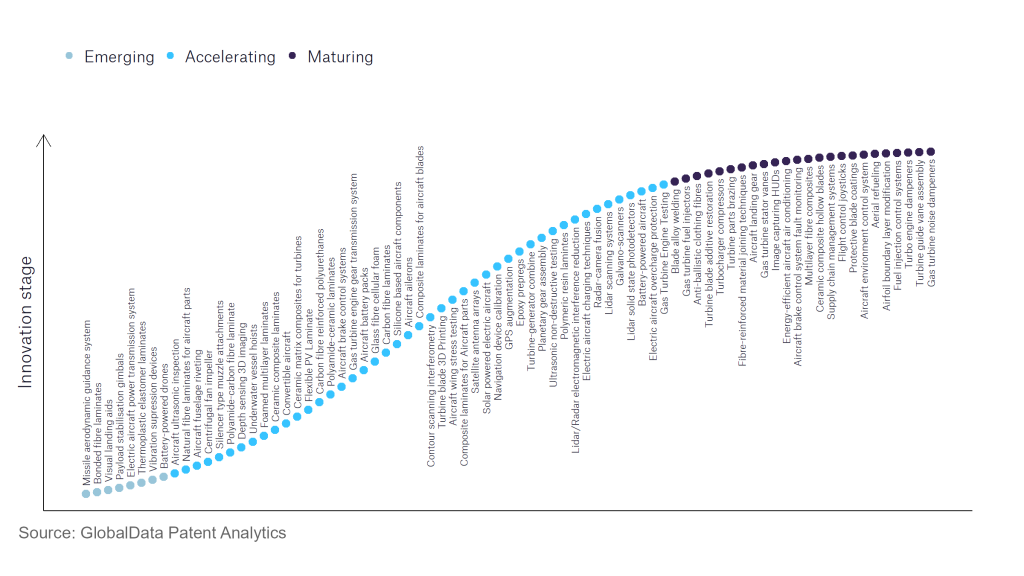The aerospace and defence industry continues to be a hotbed of innovation, with activity driven by the uptake of advanced technology, and growing importance of technologies such as hypersonics and advanced materials. In the last three years alone, there have been over 174,000 patents filed and granted in the aerospace and defence industry, according to GlobalData’s report on Innovation in Aerospace, Defence & Security: Ceramic composite laminates. Buy the report here.
However, not all innovations are equal and nor do they follow a constant upward trend. Instead, their evolution takes the form of an S-shaped curve that reflects their typical lifecycle from early emergence to accelerating adoption, before finally stabilising and reaching maturity.
Identifying where a particular innovation is on this journey, especially those that are in the emerging and accelerating stages, is essential for understanding their current level of adoption and the likely future trajectory and impact they will have.
180+ innovations will shape the aerospace and defence industry
According to GlobalData’s Technology Foresights, which plots the S-curve for the aerospace and defence industry using innovation intensity models built on over 262,000 patents, there are 180+ innovation areas that will shape the future of the industry.
Within the emerging innovation stage, bonded fibre laminates, thermoplastic elastomer laminates, and vibration supression devices are disruptive technologies that are in the early stages of application and should be tracked closely. Centrifugal fan impellers, ceramic composite laminates, and gas turbine engine testing are some of the accelerating innovation areas, where adoption has been steadily increasing. Among maturing innovation areas are protective blade coatings and blade alloy welding, which are now well established in the industry.
Innovation S-curve for the aerospace and defence industry

Ceramic composite laminates is a key innovation area in aerospace and defence
Ceramic composite laminates refer to a material that is made of layers of ceramic fibrous composite. They have significant defence application because they are intrinsically hard.
GlobalData’s analysis also uncovers the companies at the forefront of each innovation area and assesses the potential reach and impact of their patenting activity across different applications and geographies. According to GlobalData, there are 10+ companies, spanning technology vendors, established aerospace and defence companies, and up-and-coming start-ups engaged in the development and application of ceramic composite laminates.
Key players in ceramic composite laminates – a disruptive innovation in the aerospace and defence industry
‘Application diversity’ measures the number of different applications identified for each relevant patent and broadly splits companies into either ‘niche’ or ‘diversified’ innovators.
‘Geographic reach’ refers to the number of different countries each relevant patent is registered in and reflects the breadth of geographic application intended, ranging from ‘global’ to ‘local’.
Patent volumes related to ceramic composite laminates
| Company | Total patents (2021 - 2023) | Premium intelligence on the world's largest companies |
| General Electric | 291 | Unlock Company Profile |
| Safran | 148 | Unlock Company Profile |
| Raytheon Technologies | 138 | Unlock Company Profile |
| Rolls-Royce Holdings | 89 | Unlock Company Profile |
| Siemens | 47 | Unlock Company Profile |
| CEA | 43 | Unlock Company Profile |
| Boeing | 38 | Unlock Company Profile |
| Honeywell International | 31 | Unlock Company Profile |
| IHI | 23 | Unlock Company Profile |
| Elbit Systems | 18 | Unlock Company Profile |
| CDP Equity | 16 | Unlock Company Profile |
| Mitsubishi Heavy Industries | 9 | Unlock Company Profile |
| Compagnie de Saint-Gobain | 9 | Unlock Company Profile |
| Mino Ceramic | 7 | Unlock Company Profile |
| Oran Safety Glass | 5 | Unlock Company Profile |
| Berkshire Hathaway | 5 | Unlock Company Profile |
| Kolon | 5 | Unlock Company Profile |
Source: GlobalData Patent Analytics
General Electric is the largest patent filer in the aerospace sector and has developed jet engines utilising the ceramic composite laminates technology. The company has provided these engines to Boeing following demonstrations of the same operating in tough conditions, showcasing their durability. The second largest patent filer in the area is Safran, which has conducted extensive research into the topic, and has a specific division named Safran Ceramics dedicated to developing ceramic composite laminates. Other key companies in the sector include Raytheon, Rolls-Royce, CEA and Boeing.
In terms of application diversity, Raytheon is the leader, followed by Mitsubishi Heavy Industries and Rolls-Royce. By geographic reach, Kolon is top, followed by Elbit Systems and IHI.
The technology has significant potential for advancing the aerospace and defence sector, and there will be increased patent filing and investment by key players in the industry in coming years.
To further understand the key themes and technologies disrupting the aerospace and defence industry, access GlobalData’s latest thematic research report on Defence.
Data Insights
From

The gold standard of business intelligence.
Blending expert knowledge with cutting-edge technology, GlobalData’s unrivalled proprietary data will enable you to decode what’s happening in your market. You can make better informed decisions and gain a future-proof advantage over your competitors.







